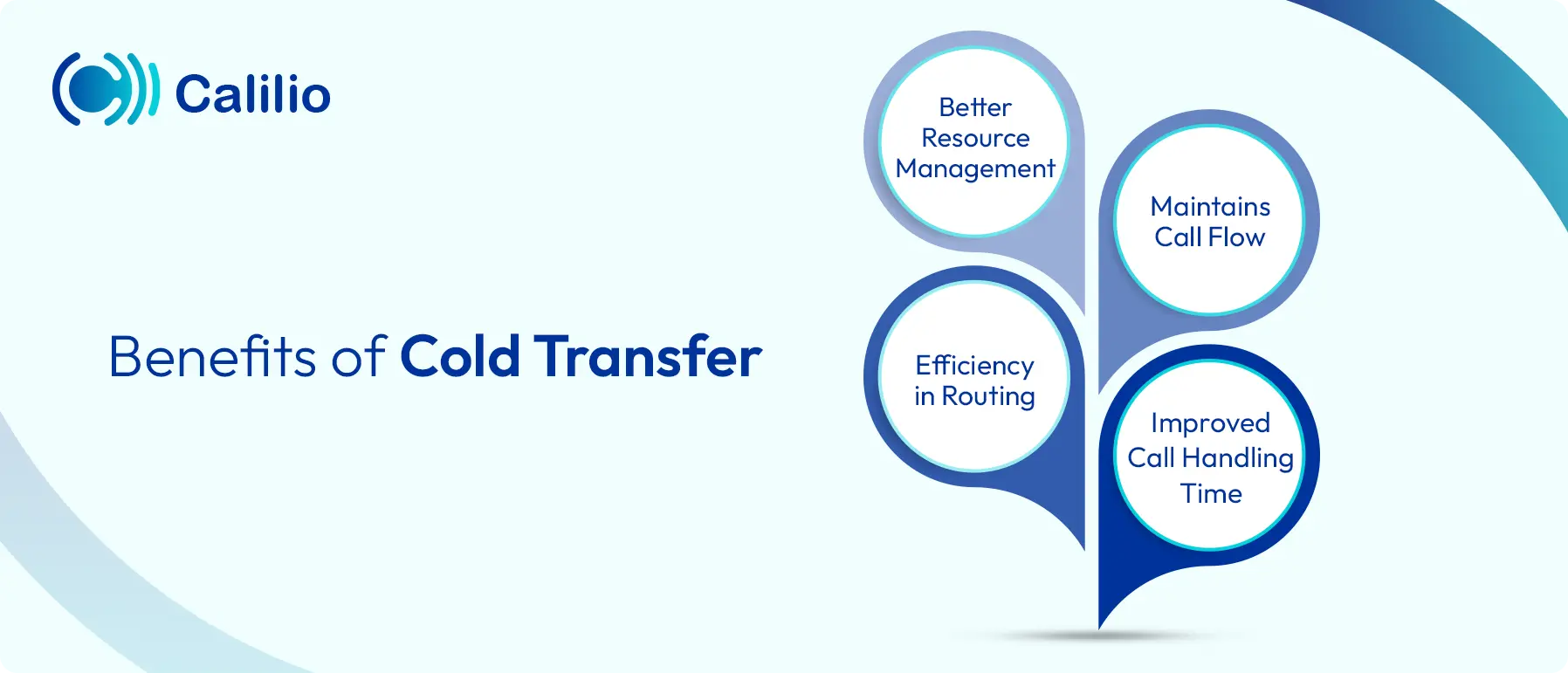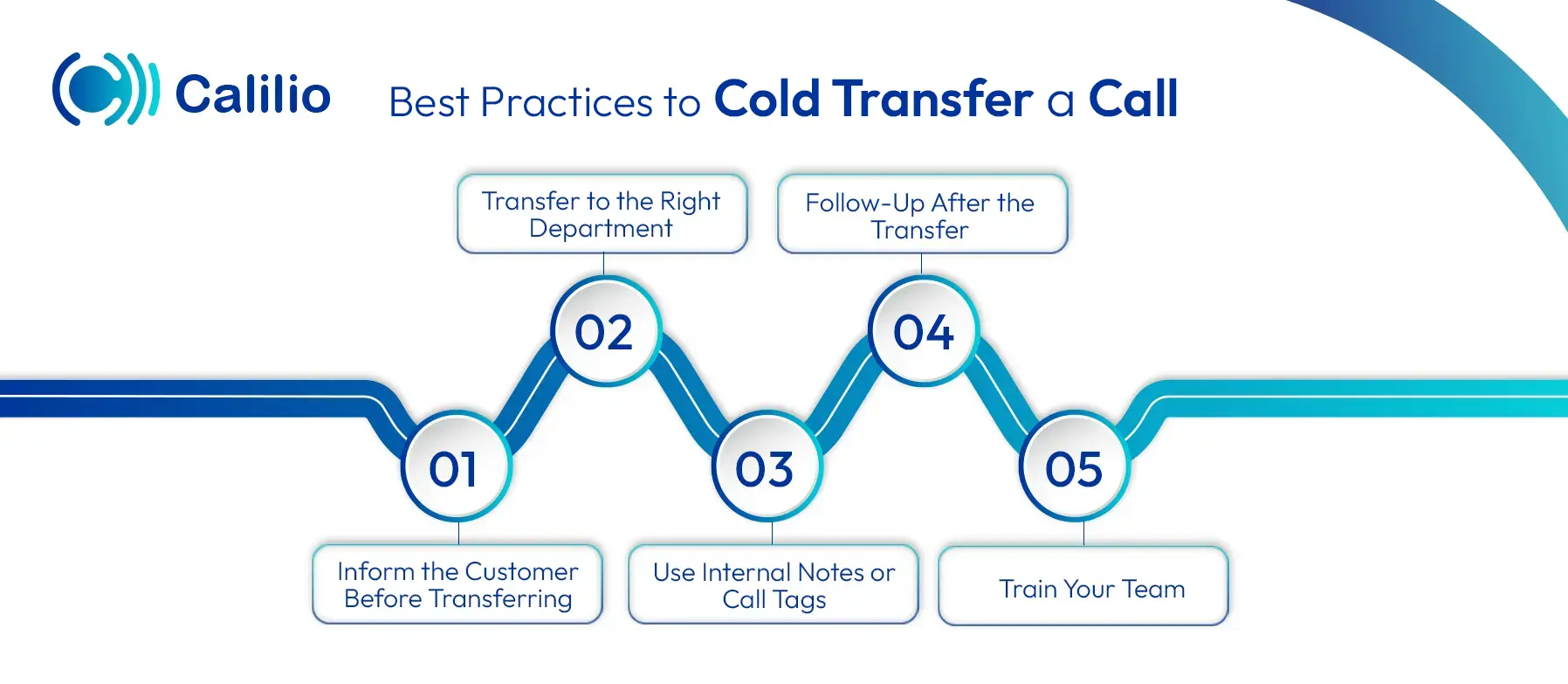What is a Cold Transfer? Meaning, Benefits, & Drawbacks

Summarize this blog with:
At times, businesses may need to handle high call volumes suddenly. In those moments, agents may get stuck on calls they can’t solve, while other customers wait in line. Without a quick way to transfer calls, your team may struggle to regain control of the situation.
Manually checking who’s available or explaining every detail before transferring takes time. It can frustrate your agents and make your service slow and disconnected.
Cold transfer helps fix this. It lets your agents send calls straight to the right person without needing to explain everything first. When used correctly, it’s a fast and effective way to keep calls moving.
In this guide, we’ll explore what cold transfer is, including its benefits, limitations, and use cases. Additionally, we’ll also look into the best practices for making effective cold transfers.
Key Highlights:
Cold transfer connects a caller to another agent without providing the context of the call to the receiving agent.
It helps route calls more efficiently, saves agents’ time, and directs customers to the correct department more quickly.
If done poorly, cold transfers can frustrate customers, cause delays, or lead to misrouted calls.
To make cold call transfers smoother, agents should inform the customer, understand the issue, and then direct the call to the appropriate person.
What is a Cold Transfer?
A cold transfer, also known as a blind transfer, is a type of call transfer where one agent transfers the call to another agent without prior communication or informing them about the caller’s issue. The call is passed directly, usually without placing the caller on hold and providing any context to the receiving agent.
This method of transfer is common in traditional PBX systems and some VoIP setups, especially when call routing isn't set up correctly. It's often used in a busy workplace when managing high call volumes.
How Does a Cold Transfer Work?
A cold transfer works by transferring a call directly from one representative to another without sharing any context or information. When the call comes in, the first agent picks up the call, and if they determine that the issue requires another department, they transfer the call immediately. The second agent answers without prior background information.
Here’s the step-by-step process of how it works:
- A customer calls for help.
- The receptionist decides that the call needs to be transferred to a different person.
- Without consulting the next person, the receptionist transfers the call to the other person.
- As soon as the new person picks up, the initial agent hangs up.
- The second agent answers the call with no context and starts the conversation from the beginning.
Handle Your Calls More Efficiently with a Convenient Call Transfer Feature!
Upgrade to a modern VoIP solution with advanced call transfer features — route inbound and outbound calls faster.
What are the Benefits of Cold Transfer?
Blind transfers route calls quickly to the right team, improves call handling time, and enhances resource management. It helps maintain a steady call flow during a busy period.

I. Efficiency in Routing
This call handling method allows agents to redirect calls to the right team. This reduces unnecessary back-and-forth and helps connect the caller to someone who’s more suited to handle the issue.
II. Better Resource Management
When combined with the right phone system, cold transfers can support better resource management. They reduce the number of steps in call handling and help teams handle larger volumes of calls without extra staffing.
III. Maintains Call Flow
In a busy environment, cold transfers help keep calls moving. This prevents long queues and ensures that customers are not waiting unnecessarily when their issue requires attention from a different team.
IV. Improved Call Handling Time
Since the transfer is immediate, it reduces the average wait time and the total time an agent spends on a call. This is useful in situations where the caller’s need is clear and does not require further explanation.
What Are the Drawbacks of Cold Transfer?
This approach often requires callers to repeat their issue, which can cause frustration and slow down the resolution process. They also increase the chance of sending the call to the wrong person, which can result in a less personal experience.
I. Repetition for the Caller
Callers may need to repeat their issue after being transferred, which adds frustration and delays resolution.
II. Lack of Context
The receiving agent has no information about the caller’s issue. They must start the conversation from the beginning. This lack of background often leads to poor resolution time and customer frustration.
III. Risk of Misrouting
Without confirming the availability or role of the next agent, the call might be sent to the wrong person or department. This wastes time and also increases the chance of dropped calls.
IV. Impersonal Experience
Since no information is shared during the transfer, agents lose the chance to greet the caller by name or continue the conversation naturally. This lack of personalized attention may negatively affect customer satisfaction and create a sense of detachment.
When To Use A Cold Call Transfer?
This type of transfer is best used when the caller’s issue is simple, the initial agent is busy, or the call needs to go to a specialized department. It’s also helpful during high call volumes to keep lines clear and avoid long wait times.
- When Handling High Call Volumes: When many calls are coming in, agents can use cold transfers to reduce wait times and keep the lines moving.
- When Immediate Assistance is Unavailable: If an initial agent needs to move on to the next call, a cold transfer ensures the customer is still connected without unnecessary delays.
- When Transferring to Specialized Departments: In teams where roles are clearly defined, agents can transfer calls directly without needing to explain the issue.
- When the Request is Simple and Direct: If the caller’s issue is straightforward and clearly belongs to another team, a cold transfer saves time and speeds up resolution.
Best Practices to Cold Transfer a Call
For a successful cold transfer of a call, inform the customer in advance, route the call to the correct department, and add internal notes if possible. After the transfer, follow up to ensure the issue is resolved and make sure agents are trained to follow clear transfer guidelines.

1. Inform the Customer Before Transferring
Always let the customer know they will be transferred and explain why. This sets clear expectations and reduces confusion during the process.
2. Transfer to the Right Department
Make sure to direct the customer to the department or expert who can handle their specific concern. This minimizes delays and ensures the customers get the right help as quickly as possible.
3. Use Internal Notes or Call Tags
If your phone system supports it, attach a quick call note or tag about the caller’s reason. Even a few words can help the next agent respond faster.
4. Follow-Up After the Transfer
Check in with the customer after the transfer to ensure their issue is resolved. This extra step demonstrates that you value their experience.
5. Train Your Team
Train your team on when to use cold transfers and when to use warm transfers. Clear guidelines reduce mistakes and help agents decide quickly.
Conclusion
Cold transfers are a common method for transferring calls between agents, particularly in fast-paced or high-volume environments. While they offer speed and efficiency, they can also lead to confusion if not done correctly.
Calilio Introduces Affiliate Program
Earn 30% lifetime commission on every paid referral.
Turn your audience, network, or customers into a recurring revenue stream.

30% recurring commission on every paid referral

Lifetime earnings for as long as the customer stays subscribed

Unique referral link with real-time tracking

Perfect for agencies, consultants, creators, and SaaS partners

Frequently Asked Questions
Can cold transfers cause dropped or misrouted calls?
Yes, if the receiving agent is unavailable or the call is sent to the wrong department, it can lead to dropped or misrouted calls. This usually happens when there's no confirmation before the transfer.
Can a cold transfer be avoided?
Do cold transfers happen in both inbound and outbound calls?
Can cold call transfers be automated?
What is the difference between warm transfer and cold transfer?

Still have questions?
Can’t find the answer you’re looking for? Please chat with our friendly team.
Stay in the loop
Get the latest call insights, trends, and updates delivered straight to your inbox.
By subscribing, you agree to receive updates from Calilio.
You can unsubscribe anytime.